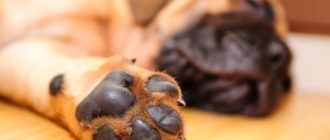View: Marten – Martes (lat.) Family: Cunyi Carnivores Class: Mammals Type: Chordate Subtype: Vertebrate Dimensions: body length – 33-56 cm, tail – 17-28 cm, height at the withers – 15 cm weight – 0.5-2.4 kg Life expectancy: up to 20 years in captivity
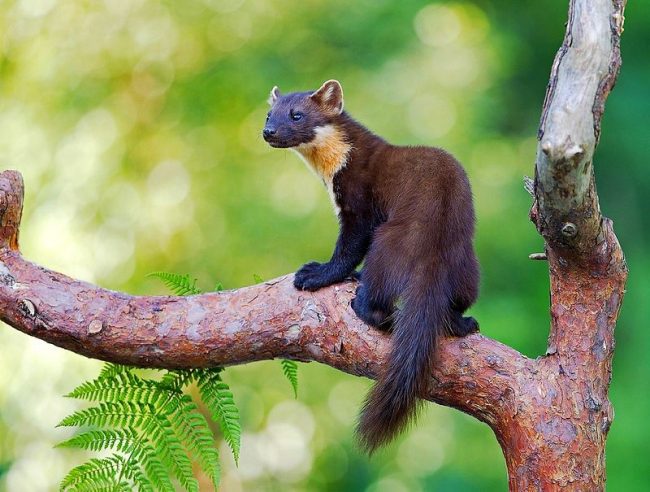
A resident of forests, the marten prefers the upper tier of centuries-old firs and pines. Nimble and unusually agile, she quickly climbs through trees, makes dizzying jumps and grabs prey on the fly
Content
- 0.1 Content
- 1 Habitat
- 2 Characteristic
- 3 Appearance
- 4 Key Features
- 5 Nutrition
- 6 Reproduction
- 7 Breeding, fishing, commercial value
Content
Contents
- Habitat
- Characteristic
- Appearance
- Key Features
- Nutrition
- Breeding
- Breeding, fishing, commercial value
A resident of forests, the marten prefers the upper tier of centuries-old firs and pines. Nimble and unusually agile, she quickly climbs through trees, makes dizzying jumps and grabs prey on the fly. Under the fragile calf the heart beats the ruthless and bloodthirsty hunter. Let’s see how the marten looks, photo, than feeds and where dwells.
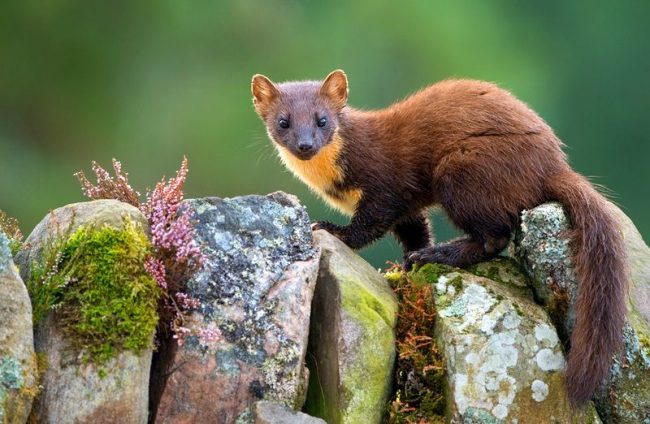
The marten chooses mature forests, with enough hollow trees and plentiful deadwood. It is in such an environment that little the predator feels comfortable arranging a house in the hollows, she rarely descends to the ground, moving along branches and trunks of trees
Habitat
Preferred forest land, martens lived quite widely territory of the earth. Their habitat begins in Western Siberia, extends to the forests of Scotland and Ireland, affects the northern area, and continues its journey south into the forest expanses of the Caucasus and The Mediterranean.
In terms of landscape, the animal selects mature forests, with sufficient the number of hollow trees and plentiful deadwood. Exactly at in such an environment the little predator feels comfortable, arranging a house in the hollows, she rarely goes down to the ground, moving around on branches and trunks of trees.
Interesting! Using your tail like the balancer, the marten jumps 4 meters, jumping from tree to tree.

The marten likes a solitary lifestyle. Pairs are formed only for offspring
Characteristic
With keen hearing, smell and vision, a large marten leads nocturnal lifestyle. She does not stay long in one place and does not tied to one den. The animal easily finds shelter in squirrel hollows and in the nests of birds, having previously ravaged them. Flexible body allows the animal to squeeze into the narrow gaps between the stones and there have a day’s rest.
The marten likes a solitary lifestyle. Pairs are formed only for receiving offspring. Beautiful hunter, animal, searching for himself feed, performs another important mission, regulating the number small rodents in her ward territory. Amazing but for one day of hunting, the animal can cover a distance of 20 km. Twisting intricate loops over its territory, the animal seeks prey until it is saturated. Having eaten, marten lays down to rest in the closest valleine closest to the place of hunting or hollow.
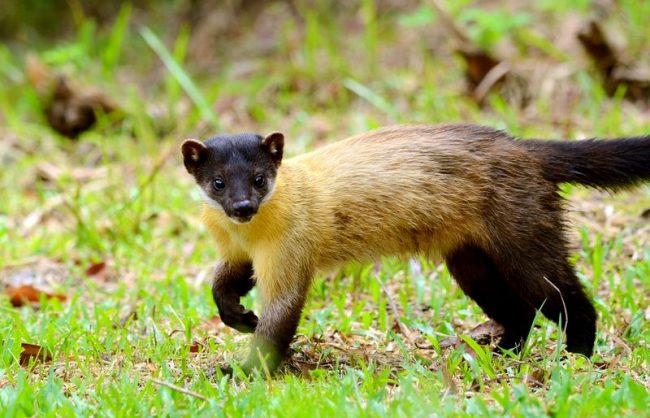
In ancient Russia, kuniy fur was highly valued and served as a monetary units. Bunches of marten skins paid for goods and services, from them received the name and monetary unit kuna
Appearance
The slender, long body of the marten is covered with fur with no less than long with a pile. In ancient Russia, kuniy fur was highly valued and performed the role of monetary unit. Bunches of marten skins paid for goods and services, from them received the name and monetary unit of the kuna.
- A beautiful yellow spot passes on the throat and on the bottom of the neck of the animal, often taking bizarre drops that accidentally fall on body of the animal.
- Neat muzzle stretched into a sharp triangle. The head crowned by fairly large ears, with slightly rounded edges.

The fur of the animal changes its color depending on the season: in winter it dark brown, with yellowish tones, dims in summer and significantly shortens in length
- The fluffy tail of the animal can be equal in length to the body. On the paws located on five fingers, with semi-retractable claws, which help the marten deftly climb trees and grab securely prey.
- The fur changes its color depending on the season: in winter it dark brown, with yellowish tones, dims in summer and significantly shortens in length.
- The back is colored darker, and the sides and abdomen take light shades of the main color.
Interesting! Among a large family there are individuals with yellow and silver fur, like a harza, in one of which species, Kharza Nilgir, throat is painted in bright orange color.

Small but surprisingly brave and strong, the marten can to cope even with a hare and curl up the capercaillie
Key Features
Not sparing walking on the ground, the marten photo most often finds animal on branches or in hollows of trees. Marten all his life moves in leaps, leaving paired footprints in the snow and the earth. Without fundamentally changing the living area, the animal may have there are several shelters for sleeping and breeding cubs. Not the small predator leaves his plot and when it becomes bad with food.
In hunting, he prefers nighttime, visiting bird nests, hollow squirrel, and a guard of small rodents, snugly sitting on a branch tree. Small but surprisingly brave and strong, the marten can deal with a hare and curl up the capercaillie.
There are frequent cases of marten visiting chicken coops. Not able to carry all prey, the animal can strangle all chickens, for which it deserved just anger of people. However, it is a mistake to think that this is greed directs the animal. Everything is much simpler: frightened by the intrusion birds of prey begin to randomly rush around, warming up the predatory the animal’s instinct, so he “calms” both them and himself.

There are frequent cases of marten visiting chicken coops. Not able to carry all prey, the animal can strangle all chickens, for which it deserved fair anger of people
Nutrition
The diet of the animal is diverse and is not limited only to meat dishes. Not for a second without losing their hunting skills, the marten with enjoys eating eggs of birds, insect larvae, wild berries, fish, frogs.
Interesting! The marten loves to visit bee hives, eating honey and larvae there. It will not pass and past the greasy caterpillar.
Such omnivore helps the animal in years, not rich in small game. In addition, the marten willingly makes reserves for the winter, scoring hollow plant products.
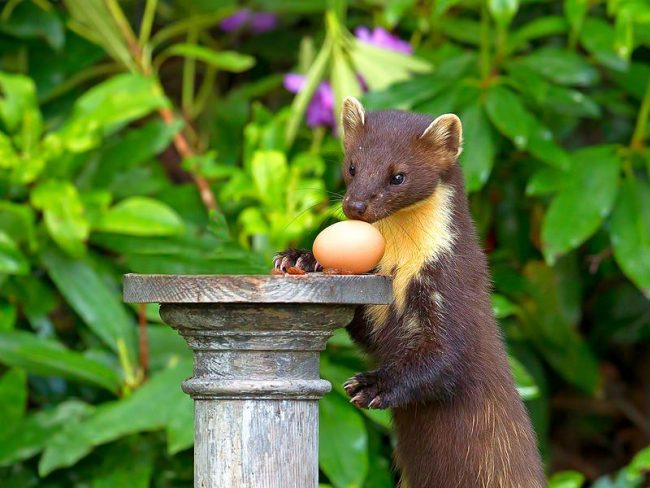
The diet of the animal is diverse and is not limited only to meat dishes. Not for a second without losing their hunting skills, the marten with enjoys eating eggs of birds, insect larvae, wild berries, fish frogs
Breeding
Puberty occurs at the age of 14 months and in the female, and the male. However, mating usually occurs at age 2 – 3 years. The mating season begins in early June and lasts until July. IN this time females go estrus, which last about 4 days, with an interval of 6 to 17 days.
Interesting! The marten’s pregnancy lasts about 28 days, but before that the latent stage of development passes, lasting 235 – 275 days.
One female brings from 2 to 7 puppies that remain with mother for 3 months. If the birth was late, then the puppies can live in their own den until spring.
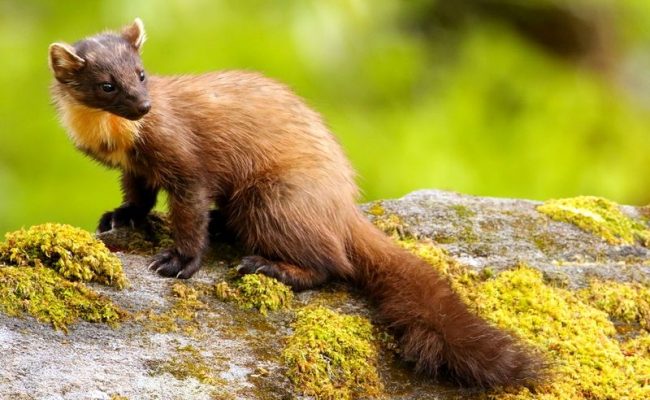
Most martens, starting with the king of sable fur, are considered valuable fur animals. Gorgeous marten fur coats adorn wardrobes of modern fashionistas and are inexpensive
Breeding, fishing, commercial value
From the family of marten only some species are not of interest in terms of fur production. Most, starting with the king of sable fur, considered valuable fur animals. Gorgeous Marten Fur Coats wardrobes adorn modern fashionistas and are inexpensive. Practical and beautiful marten fur withstands 7 seasons of socks and rightfully takes one of the leading positions in popularity lists.
Interesting! The structure of the marten fur is good it is ventilated without delaying dust particles, which increases it hypoallergenic properties.
The annual marten hunt is strictly limited due to a limited number of animals in its habitats. On the fur auctions sale of marten skins is limited to 500 pieces. In the methods of hunting the animal, the best is fishing with a dog. Traps and snares into which the animal falls do not provide high-quality raw materials. For the time that the hunter takes to check the traps, the fur has time to spoil small rodents and other predators.
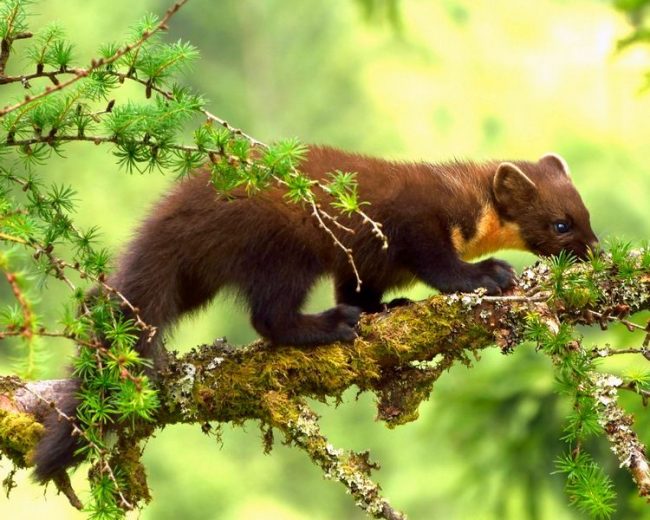
Attempts to buy marten for home maintenance often end a failure. It is difficult to find puppies received in captivity, but those brought from forests either die, or require special conditions for normal development
To meet industrial needs, active breeding of martens on fur farms. Attempts to buy a marten for home contents often fail. Find received in captive puppies are difficult, but those brought from the forest either die, or require special conditions for normal development. In a small cage they do not hold the marten, for it is necessary to build a large aviary, equipped with trees, hidden manholes and other attributes free life of the animal.
In nature, animals rarely live up to 5-6 years, but in captivity, with competent care, successfully aging, living 18 – 20 years.


